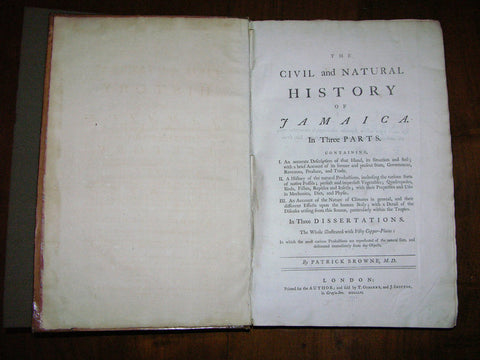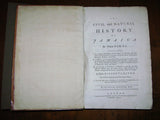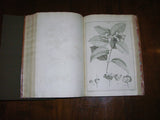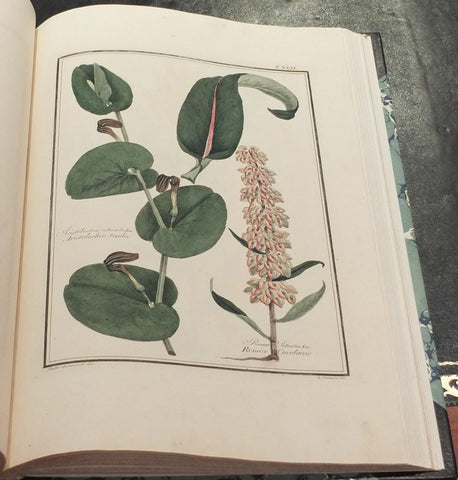Patrick Browne (ca. 1720-1790), The Civil and Natural History of Jamaica
Patrick Browne (ca. 1720-1790)
The Civil and Natural History of Jamaica
London: for the Author, 1756.
Folio (14 2/8 x 9 inches). Two fine engraved folding maps including the large folding map "A correct draught of the harbours of Port Royal and Kingston with the Keys and Shoals adjacent &c from a late accurate survey by Mr Richd Jones Engineer" and 49 engraved plates by G.D. Ehret, F. Garden and others (second map creased with several small holes catching letters and a small tear at the gutter, some plates trimmed within platemark along fore-edge with occasional loss of a few letters of imprint or printed border, some minor pale spotting and marginal staining). Contemporary calf, gilt (rebacked preserving original spine).
Provenance: Ink library stamp of the Imperial library Leningrad; 19th-century penciled annotations to endpapers and List of Subscribers; Anita Peek Gilger, M.D.
First edition. Browne, a correspondent of Linnaeus, was the first English-speaking author to use Linnaeus's system of classifying plants in print in his "History of the natural Productions, including the various Sorts of native Fossils; perfect and imperfect Vegetables; Quadrupedes, Birds, Fishes, Reptiles and Insects; and with their Properties and Uses in Mechanics, Diet, and Physic." (title-page). His "Civil and Natural History" described over a hundred new genera.
Like his father before him Ehret, who contributed a number of the botanical illustrations in this book, trained as a gardener, initially working on estates of German nobility, and painting flowers only occasionally, another skill taught him by his father, who was a good draughtsman. Ehret’s “first major sale of flower paintings came through Dr Christoph Joseph Trew, eminent physician and botanist of Nuremberg, who recognized his exceptional talent and became both patron and lifelong friend. Ehret sent him large batches of watercolours on the fine-quality paper Trew provided. In 1733 Trew taught Ehret the botanical importance of floral sexual organs and advised that he should show them in detail in his paintings. Many Ehret watercolours were engraved in Trew's works, such as ‘Hortus Nitidissimus’ (1750–86) and ‘Plantae selecta’e (1750–73), in part two of which (1751) Trew named the genus Ehretia after him.
“During 1734 Ehret travelled in Switzerland and France, working as a gardener and selling his paintings. While at the Jardin des Plantes, Paris, he learned to use body-colour on vellum, thereafter his preferred medium. In 1735 he travelled to England with letters of introduction to patrons including Sir Hans Sloane and Philip Miller, curator of the Chelsea Physic Garden. In the spring of 1736 Ehret spent three months in the Netherlands. At the garden of rare plants of George Clifford, banker and director of the Dutch East India Company, he met the great Swedish naturalist, Carl Linnaeus, who was then formulating his new classification based on plant sexual organs. Ehret painted a Tabella (1736), illustrating the system, and sold engravings of it to botanists in Holland. Some of his paintings of the exotics were engraved in Linnaeus's “Hortus Cliffortianus” (1737).
“[Ehret] signed and dated his work, naming the subject in pre-Linnaean terms. He published a florilegium, “Plantae et papiliones rariores” (1748–62), with eighteen hand-coloured plates, drawn and engraved by himself... Ehret also provided plant illustrations for several travel books [as here]. His distinctive style greatly influenced his successors” (Enid Slatter for DNB). Great Flower Books, p.52; Nissen BBI 255; Stafleu & Cowan TL2 842.
We Also Recommend









